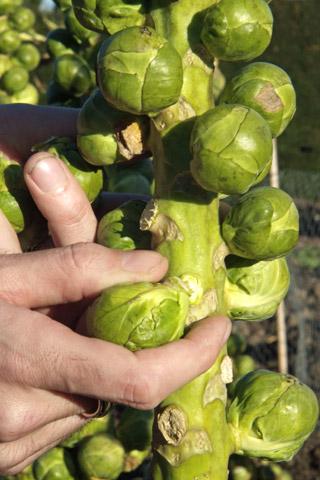 Botanical name: Brassica oleracea var. gemmifera
Botanical name: Brassica oleracea var. gemmifera- Origins: Native to the Mediterranean region along with other cabbage species
- First cultivated: Although a forerunner to the modern sprout may have been grown in Ancient Rome, Brussels sprouts, as we know them today, were first grown in 13th-century Flanders (part of modern day Belgium)
- Types: There are green varieties available (including the popular and reliable ‘Cascade’ and ‘Revenge’), and red varieties (such as ‘Rubine’)
Did you know?
Britons eat more Brussels sprouts than any other nation in Europe. Our sprout industry is worth £650m and the area covered by sprout fields in the UK is the equivalent of 3,240 football pitches. It’s fair to say that these days, no one loves sprouts more than the British.
It’s equally true that no vegetable divides opinion more than the humble Brussels sprout. While so many of us love them, others hate them, which could be due to the specific gene TAS2R38, otherwise known as the ‘Brussels sprouts gene’ which regulates bitterness perception. Or it could be down to the way they’re cooked.
The precursors to modern Brussels sprouts were grown in Ancient Rome, but the sprouts we’re familiar with were first cultivated back in the 13th century, in what is now Belgium. It is thought that the vegetable is named after the Belgian capital, where they became a popular crop in the 16th century.
Sprouts only became popular in Britain at the end of the 1800s. However, up until relatively recently, many of us were only familiar with the overboiled Brussels sprout, dished up at festive family feasts in December. Mushy, yellowing and with a smell akin to rotten eggs, the tendency to overcook sprouts helped secure its reputation as one of the nation’s most hated vegetables.
RHS advice:
How to grow Brussels sprouts
These days, steamed, sautéed and stir-fried sprouts have helped drive the popularity of the vegetable, convincing sprout sceptics that they can be rather delicious. They’re also highly adaptable. From salads and skewers to curries and pizzas, Brussels sprouts can lend themselves to most recipes. For those who insist on boiling them, there remains the contentious matter of whether a cross should be cut into its base. While some cooks believe this age-old tradition helps the vegetable cook evenly, others feel it makes no difference, and a spokesperson for the Brassica Growers Association recently claimed it ruins the vegetable!
In fact, the tradition of cutting a cross in the base of a sprout might have less to do with culinary technique and more to do with superstition. In Medieval times, it was believed that evil spirits and demons lived between the leaves of the vegetable, and they would enter anyone who ate them, making them ill. A cross cut into the base of the sprouts was thought to drive the evil spirits away.
Nowadays, we’re more familiar with the nutrients hiding inside the vegetable. An 80g serving of Brussels sprouts contains more vitamin C than an orange, which helps strengthen the immune system, repairs tissue damage and promotes iron absorption. They are also an excellent source of folic acid and beta-carotene.
There are more than 110 different varieties of Brussels sprout available, as well as the Flower Sprout, a sprout/kale hybrid which contains double the vitamin B6 and C of a traditional sprout. It’s certainly worth devoting a section of your vegetable patch to Brussels sprouts, they’re relatively easy to grow, adaptable in the kitchen, and packed full of health-boosting nutrients. And what could be better than serving up your own homegrown sprouts at Christmas?
Text provided by
Mr Fothergill's

